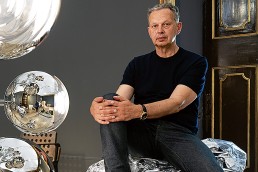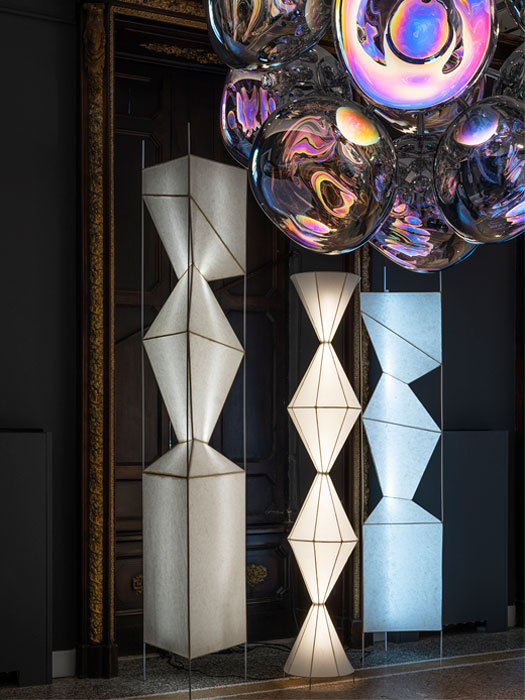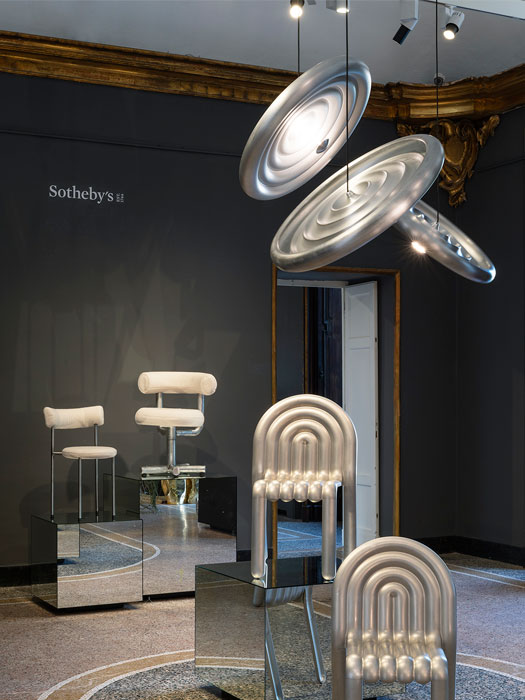
Tom Dixon
Celebrating 20 years of design, Tom Dixon launched the exhibition Twenty at Palazzo Serbelloni, a neoclassical palace where Sotheby’s has its Milan galleries and offices. Visitors were invited to explore a curated selection of designs, with 20 unseen pieces on display.
darc’s editor Sarah Cullen caught up with Dixon during an exclusive press preview of the collection in Milan to discuss the brand’s 20th anniversary and the direction he is pushing it in moving forward.
“We had a plan. Though I don’t think I was projecting it 20 years forwards from when we started, the initial idea of having the eponymous label has worked out as we hoped, but we thought [the journey] would have been a bit easier. From the perspective of mimicking let’s say the fashion industry, in terms of how you set up a business using your own name, having your own distribution, and your own communication, I didn’t realise that it would end up like this.
“Lots of stuff has changed in the interim, right? But what I didn’t realise is how much more difficult it is to cover [as a product designer] all the different categories of the home, from a distribution and logistics perspective, and the way people buy,” Dixon explains.
Further likening the varied manufacturing approaches to that of the fashion industry, Dixon explains that if you have one manufacturing technique such as sewing, for example, this can be replicated at home in the UK or in a factory in Vietnam. However, when it comes to producing homeware, every packaging box is a different size and shape, which entails different import restrictions, etc. “It’s been more difficult than I thought to do a whole interior concept, but I think the vision, if you want to call it that, and how you take control over your own destiny as a product designer is reasonably accurate,” he adds. “We are still the only company of our size that does that.”
When asked whether there was a particular design Dixon had wished to have launched by this milestone, he comments: “You have these fantasies about what people will buy and, although you gain experience and get better at predicting that, the reality is the market dictates it. And, getting things at the right price and at the right quality is tricky, particularly if you don’t have your own factory.
“We’ve become better in lighting, which is from a pull in the market. I thought we’d probably be more reflective of how people furnish their spaces, in terms of proportionality. Our lighting business is 60% of what we do, which is not equivalent to the proportion [of lighting] you have in your home or in a restaurant. The marketplace decides roughly what people will buy from you. Different parts of the world, like Hong Kong, would be much more accessories focused, for instance, and for logistical reasons, again, getting your furniture out there means much longer lead times, along with things like anti-import duties or restrictions of what type of testing you need for California; it’s a different picture for different parts of the world.
“So, it’s harder for you to have mastery over the destiny of a selection than it is to have over what the initial concept was, which is to have at least a way of creating your own universe. This is something most product designers don’t have; they’ve got an aesthetic, but their output goes to lots of other brands to be marketed and sold.”
With regards to Brexit and how it’s impacted them as a UK-based brand, Dixon describes it as a “perfect storm”.
“Brexit, if you’re an import / export business, is an abject disaster. You’d have hoped there’d be some advantage, any advantage, that had been carefully constructed behind the scenes during the three years [the government] had to sort it out, i.e., better conditions for British manufacturing, new export markets, seamless borders. But there’s none of it. It’s just become more paperwork, more inefficiency, and more unknowns – it’s a shocking picture,” he says.
Turning the conversation to Twenty, Dixon explains that the various pieces chosen were selected because they helped with getting the brand to where it is today. “I mean, to be frank, given the state of Milan – we’re going to have a little Salone in September, actually we’re going to have it in April now, no we’re now going to have it in June… – We didn’t even know if we were going to do this show this year.
“We wanted to look at some of the things that got us to where we are now and see whether they could be refreshed and rejuvenated. There are some things more experimental, and some that were so good we didn’t show them because we didn’t want to share them before they were available for sale. I might be exaggerating, but there were a couple of things that came back [from production] that were so bad we couldn’t possibly show them. So, you must be pragmatic about it.
“I also quite like showing some things that are total failures. For me, the rubber S chair is a total failure, but it’s still an amusing narrative and it’s an experiment. I also didn’t want to just look backwards – pulling out some pieces I thought were interesting that we never produced, like the paper lanterns for instance, feel relevant now.
“There were lots of ideas that went through a funnel, and what comes out the other end, comes out the other end. Then, you have some things that get stuck in customs, and others that arrived yesterday, which I’d never seen, like the aluminium lamps for instance. They looked great in 3D render, but they could have been rubbish, or they could have never turned up. There’s been some good surprises and there’s been some appalling disasters, but that’s just Milan. That’s how it rolls.”
The Melt chandelier, one of Tom Dixon’s most popular items, was selected as part of the Twenty exhibition. Dixon wanted to draw attention to it but with minimal intervention. Thus, a simple dichroic filter was added, creating an interesting and different effect to the iconic light. “We’ve all seen dichroic effects – maybe on cheap novelty sunglasses in Camden Market, or on the surface of early Roman glass in the British Museum – but I know that it’s a finish that has always fascinated me. The emergence of Modern Dichroic thin film filters, which split white light into its component colours, is the work of the engine of extreme innovation, NASA. When we looked at updating Melt, our most successful light, rather than offering a new shape, a new size, or a new colour, we decided to instead filter the light with a dichroic filter. The effect of the coated component is to channel the light of our powerful LED driver into constituent parts of the spectrum, giving the already crazed internal reflection an additional chromatic boost and an unexpected space-age aesthetic to this otherworldly lamp.”
Looking to be more sustainable in future product designs, the studio has been experimenting with various materials such as cork, mycelium, and biorock. “It’s becoming increasingly urgent. I can’t just sit around and ignore it, and so we’re doing our best to find substitute materials,” says Dixon. “The miracle with 100% recycled is you can’t really tell the difference. We thought there would be a significant drop in clarity or a significant increase in bubbles and imperfections, but it almost feels glassier because it’s not completely pristine and virgin. The only problem being is plastic is roughly 60 – 70% more expensive, so we have to see whether the market is prepared to pay for sustainability. Everybody wants to do it, but the proof is in the pudding. And I think what’s been interesting, in terms of observing how it can work, is the LED revolution where there’s a mix in legislation, which mainly came from California. This affected how the American sales worked. You can’t ignore California and then, combined with huge, amazing research, engineering and manufacturing, and progress, have designers piling on board trying to make acceptable sustainable solutions for the customer. I think it takes all three; it takes government, innovation, and science, plus some design.
“So, the difficulty with sustainability is that you see there’s an interest. People love to touch it, they want to be part of it, but will they consume it? Particularly if everything is brown. Brown has its moments, but these things are subject to fashions. I think it’s important for us to show what we’re working on, and if there’s genuine enthusiasm, we can accelerate on those things rather than making a series of mess-ups. Also, it’s never black and white. Plastic versus glass in terms of energy consumption it isn’t an obvious equation.
“We have been challenging ourselves and our factories to reduce our impact on the environment, so the monumental vertical chandelier [Mirror Ball] will be the first to display one of our oldest designs in a 100% recycled polycarbonate. The change in optical quality is imperceptible and is a demonstration of the opportunities now available in a rapidly changing landscape to try harder to find more credible alternatives to virgin material.”
Along with many other studios, the last couple of years has been a difficult one for the brand. However, Dixon admits they’ve “not thrived, but more than survived”.
He continues: “We’ve been hugely impacted from a manufacturing perspective. And it isn’t so much just manufacturing, Brexit, increasing in container costs, and the rest of it, which is a universal issue, it’s also the fact that there haven’t been any trade fairs. That makes it really hard to launch new products. Ours is a physical business where people still need to see pieces in person. It’s useless to do it on zoom.”
Looking to the future and the new generations of designers coming into the industry, darc asked for Dixon’s advice on getting yourself out there: “I think they’re in such a better position than I ever was to get attention without having to invest loads in physical showrooms. I can remember having to pay for stamps to send an invitation to a party like this, whereas now you can just gather a flash crowd in an instant – you can address the world from your bedroom. You’ve never been in a better position to make yourself visible and to sell, whether that’s on Etsy or Instagram. You’re able to create a business and FedEx your product to people all over the world from your bedroom. That’s amazing! But the most important thing then is how do you stick out from the crowd? The market is so much more saturated, and so it becomes harder and harder to make that impact even though it’s easier at the same time. So, there’s a kind of catch-22. The important thing is really finding your uniqueness and having a different point of view. There is absolutely no point in trying to be like me, or like anybody else. If you’re at the beginning of your career, you’ve got to be yourself,” he concludes.





